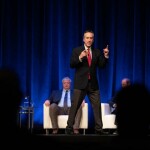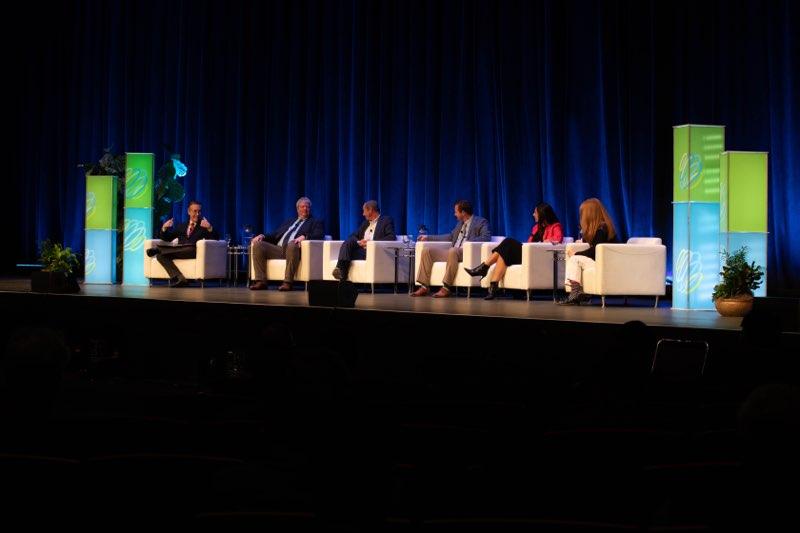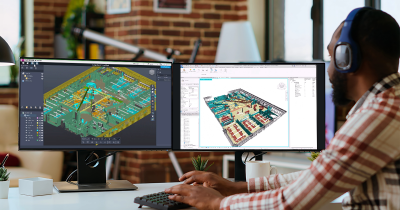“Throwing technology at a failed process is guaranteed failure.” That’s a quote from Steve Jones, Senior Director of Industry Insights Research at Dodge Data and Analytics, speaking at the opening keynote of Geo Week 2023. Jones led a panel including five other industry experts speaking about the state of digitalization in the AEC industry, and what needs to happen to continue that growth. It was a fascinating discussion, touching on all of the advances that have been made in recent years, as well as where the space still can reach and the strategies to get there.
Registration is Open for Geo Week 2024!
February 11-13, 2024 | Colorado Convention Center | Denver, CO, USA
Still, even with that growth, there is plenty of ground left to cover, more stakeholders to bring into the fold, and greater innovations to embrace. The following experts the field joined Jones on stage at the Bellco Theater in the Colorado Convention Center on Monday to discuss where the industry stands today, and how to take those crucial next steps.
- Johnny Fortune, BIM Program Director, National Institute of Building Sciences
- Greg Gidez, Director of Design Services, Hensel Phelps
- Aaron Moniza, Senior Client Manager, Foth
- Danielle O’Connell, Senior Director of Emerging Technologies, Skanska USA Building
- Claire Rutkowski, SVP, CIO Champion, Bentley Systems
Below are just a few of the crucial nuggets from the in-depth and massively informative 60-minute panel discussion on perhaps the most important conversation to be had in the behemoth that is the AEC industry.

Owners drive widespread technology adoption
It’s a plain truth that technology in many forms have long been a major part of AEC workflows in certain sections of the industry and certain departments within firms. Unfortunately, the reality in many of those firms is that the adoption has been limited to certain departments and in some cases has been more of a pet project than a key, firm-wide initiative. That is starting to change, and Jones notes that while technological adoption is growing across the board in the industry, it’s owners who are perhaps the fastest-growing section of the space.
That is a big deal for bringing this into the mainstream and making it a requirement, for reasons that are frankly fairly intuitive. Although certain stakeholders may have their expertise in specific areas, it’s the owner of a project who is ultimately driving this decision-making process and will truly drive the change. Increasingly, that is happening, and it’s only expected to continue. We’re already seeing rapid growth in owners requiring some sort of digital modeling as part of a company’s bid in at least half of their projects, and most owners say they expect that ask to become ubiquitous in recent years. In terms of BIM adoption, nothing can drive firms to make that a regular part of their process faster than it simply being a requirement to even bid on a project in the first place. Owners may not be the ones implementing every step of this digitalization – although the value in owners having these models is certainly proven – but they can certainly be the drivers.
Know what you already have in-place
One of the particularly interesting points of the conversation was around finding the best match to meet the company's needs. At this point, there are so many different solutions available on the market that it can be overwhelming finding out what you need. Rutkowski spoke to this, noting that the first step, before taking a risk and investing in a new piece of technology, is knowing what is in place, saying, “You’d be amazed how much technology you already have in your company that is shelfware that nobody’s using yet.”
She notes that it’s important for a company, after identifying a need that can be addressed by new technology, to first see if a solution that is already in-house can solve a need. From there, the next step is to approach vendors with whom a relationship already exists to see if they have a solution that could address that identified need. Only after those options have been exhausted is it worth looking to outside parties to find a potential solution. In this discussion, O’Connell talked about “app fatigue” – something that even those outside of AEC have experienced – and that simply adding more applications to the pile is eventually, and probably sooner than later, only going to lead to diminishing returns.

Scaling is the hardest part
It’s great when one team within a firm finds a piece of technology that can take their production to a new level, but the real challenge for most organizations is scaling that adoption beyond that singular team throughout the entire company. If the industry is ever going to meet its potential in technological adoption, and by extension in efficiency, that scaling is going to be necessary. Once again, this was something Rutkowski spoke to at length, calling out the ADKAR method developed by Prosci. To sum that up briefly, the method calls first for awareness of an issue, followed by desire to be part of the change, knowledge of what the change entails, gaining the ability to implement that change, and reinforcement to sustain it.
She continued, “What are you going to do with the people who keep throwing potshots or just refuse to use your technology? Do you have a way to take away the old way? Or let's be a little more positive. Instead of a stick, do you have the carrot? Can you incentivize people to say ‘Hey, 50% of the components on this design reused from our component center. Way to go on driving efficiency! You get a prize for that.”
Gidez backed much of that up as well, self-identifying as a skeptic in this area. He said, “Well, first you’ve got to overcome the naysayers like me who say it's not gonna work. You’ve got to give them something to go on that says ‘Yes, it’s going to work,’ so you can get buy-in from them.” And that’s really the key. While it’s easier said than done, to get the skeptics on board, it’s absolutely necessary to show clear proof that this innovation will work.

Integration and interoperability will drive the next steps
If you ask those in the industry the main barriers that are holding AEC back from truly embracing these technological solutions, one of the most common answers you’re sure to hear is that everything is too siloed, and there are too many different solutions a firm needs to implement to get the desired result. At the end of the day, it’s simply not worth it for most firms to deal with that, going back to that idea of “app fatigue” mentioned above. For mass adoption, the solution providers are going to need to be more interoperable.
In talking about this, Fortune made the apt comparison to how cell phones work. We all have differences in our individual cell phones, whether it be the manufacturer, the model, or the provider, but at the end of the day we can all call and message each other. That interoperability exists for everyone to get the value, while the providers are also getting the value they’re seeking as well. It’s no different for AEC providers. New solutions that come out have to address a clear need and replace an existing platform – once again calling back to “app fatigue” – and they need to communicate with each other seamlessly and effectively. Until that happens, there is a ceiling to how much of this adoption can truly take hold.
Still, with all of that being said, one thing this keynote made clear is that the people are in place to make wider adoption happen and for it to eventually be ubiquitous in the industry. The Geo Week panel laid out the steps that need to be taken, now it’s just a matter of putting that into practice and taking the AEC space to where it can, and should, be.






